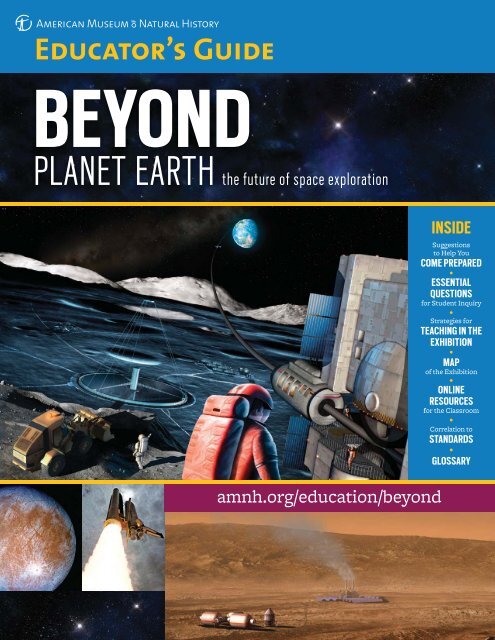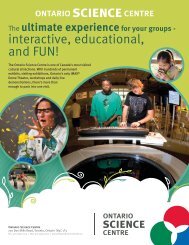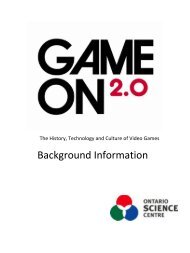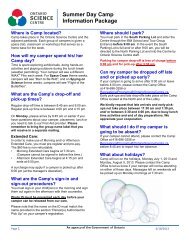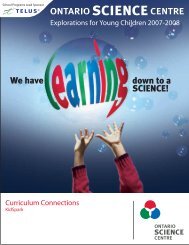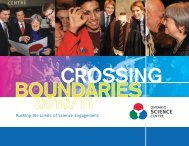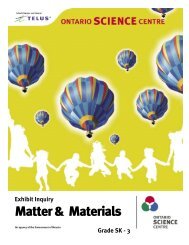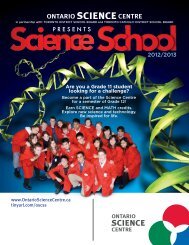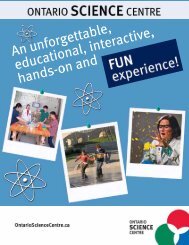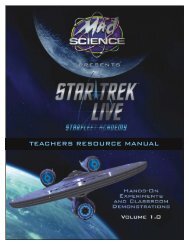Educator's Guide - Ontario Science Centre
Educator's Guide - Ontario Science Centre
Educator's Guide - Ontario Science Centre
You also want an ePaper? Increase the reach of your titles
YUMPU automatically turns print PDFs into web optimized ePapers that Google loves.
Educator’s <strong>Guide</strong><br />
BEYOND<br />
PLANET EARTH the future of space exploration<br />
amnh.org/education/beyond<br />
INSIDE<br />
Suggestions<br />
to Help You<br />
COME PREPARED<br />
•<br />
ESSENTIAL<br />
QUESTIONS<br />
for Student Inquiry<br />
•<br />
Strategies for<br />
TEACHING IN THE<br />
EXHIBITION<br />
•<br />
MAP<br />
of the Exhibition<br />
•<br />
ONLINE<br />
RESOURCES<br />
for the Classroom<br />
•<br />
Correlation to<br />
STANDARDS<br />
•<br />
GLOSSARY
essential QUESTIONS<br />
Ever since we first looked up at the night sky, space has captured our imagination. This exhibition is a journey across<br />
the solar system and into the future, from the first manned space mission to the colonization of Mars. Use the<br />
Essential Questions below to connect the exhibition’s themes to your curriculum.<br />
why explore space<br />
As humans, we seek to understand our world. We inhabit every<br />
continent, have planted flags at the Poles, and descended into<br />
deep ocean trenches. Looking beyond Earth, the potential for<br />
new discoveries is tremendous, but many unknowns remain.<br />
Will space tourism become commonplace How can we protect<br />
our planet from an asteroid impact Is there life beyond Earth<br />
Can we establish a research station on the Moon Could we<br />
make Mars habitable for humans<br />
how will we explore space<br />
People first “explored” space with the naked eye, but they<br />
observed only a small fraction of what we now know exists.<br />
The telescope brought more things into view: smaller and<br />
more distant planets, dimmer stars. Hand-held telescopes gave<br />
way to larger ones like those atop Hawaii’s dormant Mauna<br />
Kea volcano, above much of the haze of the atmosphere.<br />
Telescopes like Hubble now orbit Earth, transmitting detailed<br />
images of the cosmos. Humans have walked on the Moon, and<br />
hundreds have lived and worked in the International Space<br />
Station. Unmanned spacecraft carry out missions too distant or<br />
dangerous for humans; the Voyager 1 and 2 space probes have<br />
even left our solar system.<br />
Soon, the James Webb Space Telescope will look further into<br />
space than ever before, connecting our Milky Way to the Big<br />
Bang. Commercial spacecraft will take thousands of people into<br />
space — even if only for a few minutes each! What’s next Here<br />
are some possibilities, some closer to being realized than others:<br />
Nearer term:<br />
• establishing a semipermanent<br />
base on<br />
the Moon: scientists<br />
and explorers may live<br />
for weeks or months at<br />
a time in expandable<br />
modules along the<br />
rim of the South Pole’s<br />
Shackleton Crater.<br />
This visualization shows how Curiosity’s arm would<br />
examine rocks on Mars for signs of ancient life.<br />
• searching for life on<br />
Mars and Europa:<br />
scientists hope<br />
to find evidence of life<br />
beneath the Martian<br />
surface; robots may<br />
search the salty<br />
ocean of Jupiter’s<br />
moon Europa for<br />
extremophiles.<br />
• discovering exoplanets: researchers have already identified<br />
well over a thousand planets orbiting other stars, and many<br />
more such discoveries are certain. If some of these faraway<br />
worlds prove Earthlike, scientists will investigate them for<br />
evidence of life.<br />
Longer term:<br />
• building a lunar elevator: tethered to a space station, it could<br />
help transport goods and people between Earth and the Moon.<br />
• docking with asteroids: astronauts could mine space rocks<br />
for rare metals and deflect those that might collide with Earth.<br />
• terraforming Mars: one day, scientists and engineers will<br />
be able to transform the planet’s surface and atmosphere,<br />
making it habitable for our descendants.<br />
what are the challenges<br />
of space exploration<br />
Earth’s atmosphere provides living organisms with breathable<br />
air and a temperate climate, and also shields us from dangerous<br />
radiation and most meteor impacts. Traveling and living<br />
beyond its protection presents massive challenges. To survive<br />
en route, we would need to bring our own air, food, and water;<br />
avoid debris; shield ourselves from high-energy radiation; and<br />
prevent the debilitating effects of long-term weightlessness.<br />
Extreme isolation and long confinements in small spaces<br />
could take a psychological toll, as could the possibility of never<br />
returning to Earth. Once at our destinations, supplies and<br />
spare parts would be severely limited, and the margin for error<br />
tiny. To protect future generations of astronauts, engineers<br />
are at work on innovations such as improved space suits and<br />
micrometeoroid shielding. Faster propulsion systems would<br />
reduce or eliminate many of these challenges — and put ever<br />
more distant destinations within our reach.
GLOSSARY<br />
asteroids: small rocky and metallic bodies,<br />
most of which orbit the Sun between Mars and<br />
Jupiter. Meteors (“shooting stars”) are small pieces<br />
of asteroids or comets that enter Earth’s atmosphere,<br />
where most burn up. The few that land on Earth<br />
are called meteorites.<br />
exoplanets: planets that orbit stars other<br />
than our Sun<br />
extremophiles: organisms adapted to<br />
harsh environments, including extreme cold, dryness,<br />
radiation, darkness, and chemicals that would be toxic<br />
to most other organisms. Examples on Earth include<br />
bacteria in the cooling pools of nuclear reactors, in<br />
hydrothermal vents on the ocean floor, and in the dry<br />
valleys of Antarctica.<br />
hubble space<br />
telescope:<br />
a telescope launched in<br />
1990 into low-Earth orbit,<br />
whose detailed images<br />
of cosmic objects have<br />
led to many important<br />
discoveries. Hubble’s<br />
cameras detect ultraviolet,<br />
visible, and infrared light.<br />
james webb space telescope:<br />
scheduled to launch in 2018 and designed primarily to<br />
detect infrared light, this large telescope will observe<br />
extremely distant objects — including the first stars<br />
and galaxies that formed in the universe.<br />
potentially hazardous object:<br />
any near-Earth asteroid or comet that is longer than<br />
150 meters (500 feet) and that comes within 8 million<br />
kilometers (5 million miles) of Earth’s orbit<br />
rare earth metals: a group of metals<br />
that have many commercial uses but are expensive<br />
to mine on Earth<br />
shackleton crater: a crater near the<br />
Moon’s South Pole that contains ice. The rim, which has<br />
abundant sunlight, has been proposed as a possible<br />
location for a lunar base camp.<br />
terraform: the process of making another<br />
planet or moon more Earthlike<br />
COME PREPARED<br />
Plan your visit. For information about reservations, transportation,<br />
and lunchrooms, visit amnh.org/education/plan.<br />
Read the Essential Questions in this guide to see how themes in<br />
Beyond Planet Earth connect to your curriculum. Identify the key points<br />
that you’d like your students to learn from the exhibition.<br />
Review the Teaching in the Exhibition section of this guide<br />
for an advance look at the specimens, models, and interactives<br />
that you and your class will be encountering.<br />
Download activities and student worksheets at<br />
amnh.org/resources/rfl/pdf/beyond_activities.pdf.<br />
Designed for use before, during, and after your visit, these activities<br />
focus on themes that correlate to the NYS <strong>Science</strong> Core Curriculum:<br />
K–2: Objects in the Sky<br />
3–5: Observing Our Solar System and Beyond<br />
6–8: Modeling the Solar System<br />
9–12: The Future of Space Exploration<br />
Decide how your students will explore Beyond Planet Earth.<br />
Suggestions include:<br />
• You and your chaperones can facilitate the visit using the<br />
Teaching in the Exhibition section of this guide.<br />
• Your students can use the student worksheets to explore the<br />
exhibition on their own or in small groups.<br />
• Students, individually or in groups, can use copies of the<br />
map to choose their own paths.<br />
CORRELATIONS TO NATIONAL STANDARDS<br />
Your visit to the Beyond Planet Earth exhibition can be correlated<br />
to the national standards below. See the end of this guide for a full<br />
listing of New York State standards.<br />
<strong>Science</strong> Education Standards<br />
All Grades • A2: Understanding about scientific inquiry • E1: Abilities<br />
of technological design • E2: Understanding about science and<br />
technology • F1: Personal health • G1: <strong>Science</strong> as a human endeavor<br />
K–4 • B2: Position and motion of objects • D2: Objects in the sky<br />
• D3: Changes in Earth and sky • F3: Types of resources<br />
5–8 • B2: Motions and forces • D3: Earth in the solar system<br />
• F2: Populations, resources, and environments • F3: Natural hazards<br />
• G3: History of science<br />
9–12 • B4: Motions and forces • D2: Objects in the sky • D3: Changes<br />
in Earth and sky • E4: Origin and evolution of the universe<br />
• F3: Natural resources • G3: Historical perspectives
teaching in the EXHIBITION<br />
What would it be like to travel beyond Earth Starting with the Moon,<br />
our closest neighbor, and heading out across our solar system, this<br />
exhibition uses models, artifacts, videos, dioramas, and hands-on and<br />
computer interactives to immerse visitors in the high-stakes adventure<br />
of space exploration. The main sections of the exhibition represent<br />
different destinations in space. Have students explore each environment,<br />
and consider how scientists and engineers would approach the unique<br />
challenges that each presents. Answers to the questions can be found<br />
online at amnh.org/resources/rfl/pdf/beyond_teaching.pdf<br />
history of space<br />
exploration<br />
As you enter, examine some artifacts<br />
of manned and unmanned space<br />
voyages, which include models of<br />
Sputnik and a Mars Rover, and a<br />
diorama depicting the final Hubble<br />
Space Telescope upgrade. Have students<br />
watch the six-minute film in the theater,<br />
and then discuss which destinations<br />
they find the most intriguing.<br />
overview: The historic Apollo missions of the 1960s and<br />
‘70s brought back rocks that taught us a great deal about the<br />
history of the Moon — and of Earth. Astronauts visited the<br />
surface of the Moon, but only for a few days at the most. The<br />
next step could be to establish a semi-permanent scientific<br />
research station. Have students imagine what it would be<br />
like to live and work in this desolate environment. Encourage<br />
them to look for their home planet in the sky.<br />
challenges & approaches:<br />
• Base Camp, Moon’s South Pole: Have students explore this<br />
lunar crater and consider why scientists think the rim would<br />
be a suitable location for a base camp. Ask what hazards<br />
astronauts would face on the surface of the Moon, and how<br />
they could protect themselves.<br />
• Liquid Mirror Telescope<br />
Interactive: Ask students<br />
what problems astronomers<br />
confront when using telescopes<br />
on Earth’s surface.<br />
What makes conditions on<br />
the Moon more favorable<br />
for astronomy<br />
• Lunar Elevator Model:<br />
Held in place by gravity,<br />
this solar-powered elevator<br />
would travel between a<br />
space station and the Moon.<br />
Ask the class to consider the advantages of an elevator over<br />
a rocket. Have students find information that helps them<br />
imagine what a trip on this “space elevator” might be like.<br />
This liquid mirror telescope, the largest<br />
on Earth, is 6 meters (20 feet) across.<br />
On the Moon, undisturbed by wind or<br />
weather, the surface could be larger<br />
than a football field.<br />
overview: Most asteroids orbit between Mars and<br />
Jupiter, but some cross Earth’s orbit. Collisions are rare but can<br />
be devastating, so scientists are developing technologies to<br />
deflect near-Earth asteroids (NEAs). Some asteroids may also<br />
contain rare Earth and other valuable metals.<br />
This is an a illustration of a possible system for anchoring to the surface of an asteroid.<br />
challenges & approaches:<br />
• Itokawa Model: Invite students to examine a model of this<br />
NEA and the robotic Japanese spacecraft that docked with<br />
it. Ask them to think about what it would be like to study an<br />
object that has so little gravity that they couldn’t stand on it.<br />
• Potentially Hazardous NEAs: Suggest that students use<br />
the interactive kiosk to explore different ways to alter an<br />
asteroid’s course. If an object looks like it might collide with<br />
Earth, what could we do about it
overview: Mars is more likely to harbor life than any<br />
other known planet. Features like immense dry riverbeds hint<br />
at an ancient environment that could have supported life —<br />
and still might, if liquid water exists below the surface. Orbiters<br />
have mapped the entire Red Planet, rovers and probes have<br />
studied the surface in detail, but no humans have traveled<br />
there. Some scientists wonder whether, in the distant future,<br />
we might make this dusty planet habitable for humans.<br />
challenges & approaches:<br />
• Getting There and Daily Life: On the outbound journey,<br />
astronauts might spend six to nine months in very tight<br />
quarters, coping with the effects of weightlessness and solar<br />
radiation. Have students explore this section to see how<br />
people could stay safe and healthy (and keep stuff from<br />
floating away). Have them take the Mars Personality Test to<br />
see if they have what it would take to reach the Red Planet<br />
and live and work there.<br />
• Mars Explorer and Mars Environment: Have students use<br />
the interactive to examine the surface of Mars. Ask what<br />
features they observe that Mars shares with Earth. In what<br />
ways are the two planets very different<br />
• Curiosity Mars Rover: The primary mission of this roving<br />
science lab is to search for signs of habitable environments.<br />
Ask students what kinds of tools Curiosity carries, and what<br />
they measure.<br />
• Terraforming Table: Explain that terraforming is the process<br />
of making a planet more Earthlike so that it could become<br />
habitable for humans. Ask students to investigate how to turn<br />
this cold and barren planet into a wet, warm, fertile world.<br />
overview: The giant planets of the outer solar system —<br />
Jupiter, Saturn, Uranus, Neptune — together have more than<br />
160 moons. One of Jupiter’s moons, Europa, intrigues scientists<br />
because they think it may have a deep saltwater ocean that<br />
could contain life.<br />
challenges & approaches:<br />
• Europa Theater and Model of Submersible: Ask students<br />
to think about this moon’s unique environment. Have<br />
students watch the six-minute movie and reflect on how this<br />
mission would compare to journeys to Mars or the Moon.<br />
An enhanced<br />
color photograph<br />
of Europa’s cracked<br />
ice surface.<br />
beyond: All the places that your class has explored<br />
so far belong to our own solar system. But scientists<br />
have already found evidence of over 1,000 other<br />
solar systems — stars with planets orbiting them —<br />
in our Milky Way galaxy alone. How many more remain<br />
to be discovered<br />
As students experience the holographic representation,<br />
ask them to think about other worlds we may explore<br />
someday. What do they imagine we might find<br />
These illustrations show how, over hundreds or even thousands of years, Mars might be transformed from a frigid, barren planet into a warm and fertile one like Earth.
online RESOURCES<br />
our moon<br />
sciencebulletins.amnh.org/sid=a.v.moon.20061004<br />
This visualization shows how a violent collision could have<br />
given birth to our Moon in just one month.<br />
geologists on mars<br />
sciencebulletins.amnh.org/sid=a.f.mars.20040401<br />
This 8-minute video describes the 2004 Mars Exploration<br />
Rover mission that found evidence of liquid water.<br />
impact! tracking near-earth asteroids<br />
sciencebulletins.amnh.org/sid=a.f.nea.20050504<br />
This 7-minute video explores the risks of an asteroid hitting Earth,<br />
and how astronomers track the orbits of near-Earth objects.<br />
planetary mysteries<br />
amnh.org/ology/planetology<br />
Learn how scientists study our solar system, and about some<br />
of the big questions that remain unanswered.<br />
space travel guide<br />
amnh.org/ology/spacetravel<br />
This drawing and storytelling activity helps kids combine fact<br />
and fantasy on a trip to outer space.<br />
a closer look at mars<br />
amnh.org/ology/closer_look_mars<br />
Kids help reporter Stella Stardust learn more about Earth’s<br />
closest neighbor.<br />
are you cut out for mars<br />
amnh.org/ology/mars_quiz<br />
Kids can take this quiz to see if they’re up for the challenge.<br />
in pictures: beyond planet earth<br />
amnh.org/ology/inpics_beyond<br />
This photo gallery illustrates some of the places in our solar<br />
system that humans might someday explore.<br />
journey into space: gravity, orbits,<br />
and collisions<br />
teacher.scholastic.com/activities/explorations/space<br />
This interactive introduces students to the ways in which<br />
gravity shapes the universe.<br />
nasa: exploration<br />
nasa.gov/exploration<br />
Feature stories about missions, discoveries, and other<br />
initiatives describe the next era of space exploration.<br />
nasa: for students<br />
nasa.gov/audience/forstudents<br />
This NASA portal offers current science content, activities,<br />
events, images, podcasts, educational video segments,<br />
and more.<br />
google earth<br />
google.com/earth<br />
Now you can use Google Earth to view stars, constellations,<br />
and galaxies, as well as the surfaces of Mars and the Moon.<br />
DID YOU KNOW<br />
When you’re in space, the sky looks black because there’s no<br />
air for visible light to bounce off of.<br />
Space is silent. We hear because of pressure waves in the air,<br />
and there’s no air in space.<br />
Everything in the universe — planets, asteroids, and<br />
even black holes — gives off light. But almost all of it is at<br />
wavelengths that our eyes cannot see.<br />
The light that we see from stars has taken years — typically<br />
millions and sometimes billions of years — to reach us. For<br />
example, if a star 100 million light years away exploded<br />
today, people on Earth wouldn’t see the explosion for<br />
100 million years.<br />
CREDITS<br />
Beyond Planet Earth: The Future of Space Exploration is organized by the<br />
American Museum of Natural History, New York (www.amnh.org) in collaboration with<br />
MadaTech: The Israel National Museum of <strong>Science</strong>, Technology, & Space, Haifa, Israel.<br />
Beyond Planet Earth is made possible through the sponsorship of<br />
And is proudly supported by Con Edison.<br />
PHOTO CREDITS<br />
Cover: star field, Europa, and Columbia shuttle, © NASA; lunar elevator, © AMNH;<br />
terraforming Mars, © Steven Hobbs. Essential Questions: lunar South Pole and Curiosity,<br />
© NASA. Glossary: Hubble, © NASA. Come Prepared: Moon walk,<br />
© NASA. Teaching in the Exhibition: Moon, Mars, Europa, asteroid illustration, and<br />
Europa surface, © NASA; Itokawa, © JAXA; liquid mirror telescope, courtesy of P. Hickson/<br />
University of British Columbia; terraforming Mars, © Steven Hobbs. Insert: spacesuit,<br />
© Douglas Sonders; Nautilus-X, © John R. Whitesel; Curiosity, © NASA; liquid mirror<br />
telescope illustration, courtesy of P. Hickson/University of British Columbia.<br />
Major funding has been provided by the Lila Wallace – Reader’s Digest Endowment Fund.<br />
Additional support is generously provided by<br />
Marshall P. and Rachael C. Levine<br />
Drs. Harlan B. and Natasha Levine<br />
Mary and David Solomon.<br />
Funding for the Educator’s <strong>Guide</strong> has been provided in part by the<br />
Buehler Aviation Research Foundation, Inc.<br />
General support has been provided in part by Aerin Lauder Zinterhofer and Eric Zinterhofer.<br />
Presented with special thanks to NASA.<br />
© 2011 American Museum of Natural History. All rights reserved.<br />
Cert o. n XXX-XXX-XXXX<br />
XX%
BEYOND PLANET EARTH the future of space exploration<br />
><br />
Exit<br />
What would it be like to travel beyond Earth<br />
Starting with the Moon, our closest neighbor, journey<br />
across our solar system and into the future in this<br />
adventure of space exploration.<br />
history of space exploration<br />
Examine some artifacts of manned and unmanned<br />
space voyages.<br />
moon<br />
Astronauts of the 1960s and ‘70s visited the Moon,<br />
but only for a few days at the most. The next step could<br />
be to establish a semi-permanent scientific research<br />
station. What would it be like to live and work there<br />
near-earth asteroids<br />
Most asteroids orbit between Mars and Jupiter, but<br />
some cross Earth’s orbit. Collisions are rare but can<br />
be devastating. How would we deflect near-Earth<br />
asteroids that get too close for comfort<br />
mars<br />
Mars is more likely to harbor life than any other known<br />
planet. Features like immense dry riverbeds hint at<br />
an ancient environment that could have supported<br />
life. Could we someday make this arid planet habitable<br />
for humans<br />
europa<br />
One of Jupiter’s moons, Europa, intrigues scientists<br />
because there is likely a saltwater ocean. Could there<br />
be life beneath its surface<br />
beyond...<br />
Scientists have already found evidence of over 1,000<br />
other solar systems. Billions of other worlds remain<br />
to be discovered, characterized, and eventually explored.<br />
INTERACTIVE<br />
VIDEO<br />
EXHIBIT<br />
><br />
Enter<br />
© 2011 American Museum of Natural History. All rights reserved.
DOING SCIENCE in space<br />
<strong>Science</strong> in space involves extraordinary challenges. Here are some of the questions scientists are asking, and some<br />
of the technologies that are enabling them to travel farther more safely, and to gather evidence from places too<br />
dangerous — or still too distant — for humans to visit.<br />
how can scientists<br />
investigate space first hand<br />
Today’s bulky, heavy suits<br />
surround astronauts with<br />
pressurized air. This sleek<br />
new spacesuit applies<br />
pressure directly to the<br />
skin by wrapping the body<br />
tightly in several layers<br />
of stretchy, very tough,<br />
spandex and nylon. This<br />
makes the suit lighter,<br />
safer because it won’t lose<br />
pressure if punctured or<br />
torn, and easier to move<br />
and work in.<br />
how do we look for<br />
evidence of life on mars<br />
A one-ton science lab, the Curiosity rover will land on Mars<br />
inside Gale Crater, which is thought to have once been a lake.<br />
The rover will make its way to the top, studying each layer<br />
of sediment in order to obtain a cross-section of the crater’s<br />
history when it was wet, and possibly home to living things.<br />
Curiosity can pick up samples and test them onboard, fire<br />
a laser at objects to see what they’re made of, and it even<br />
contains a small weather station.<br />
how do we travel<br />
further and stay longer<br />
The Nautilus-X spacecraft could carry a crew of nine on<br />
a two-year voyage — long enough to reach Mars. It would<br />
contain exercise machines, so astronauts could keep their<br />
muscles and bones strong. Spinning compartments for<br />
sleeping would also prevent bone loss and other health<br />
problems by generating artificial gravity. Solid waste from<br />
toilets could be used as compost for plants that in turn<br />
would provide food and oxygen.<br />
how can we see further<br />
into space and back in time<br />
A liquid mirror telescope at the Moon’s<br />
South Pole could detect infrared light<br />
from the earliest days of the universe,<br />
some 13.7 billion years ago. Larger<br />
than a football field, the telescope<br />
would have a main mirror made<br />
of a slowly spinning, highly<br />
reflective liquid. A rotating dish<br />
naturally forms a parabolic<br />
shape, which focuses light<br />
from diffuse sources such<br />
as incoming starlight. With<br />
no interference from wind<br />
or weather, this surface<br />
would be so smooth it looks<br />
solid. Once spinning on electromagnetic<br />
bearings, the telescope would need little maintenance.<br />
© 2011 American Museum of Natural History. All rights reserved.
Beyond Planet Earth • New York State <strong>Science</strong> Core Curriculum<br />
Elementary School<br />
Standard<br />
Standard 4: The<br />
Physical Setting<br />
Standard 4: The Living<br />
Environment<br />
Middle School<br />
Standard<br />
Standard 4: The<br />
Physical Setting<br />
Standard<br />
Major Understanding<br />
History of Space<br />
Exploration<br />
Moon<br />
Near-Earth<br />
Asteroids<br />
Mars<br />
Outer Solar<br />
System and<br />
Beyond<br />
1.1a Natural Cycles and patterns (Earth and Moon). x x<br />
1.1c The Sun and other stars appear to move in a recognzable pattern<br />
both daily and seasonally.<br />
x<br />
5.1f Mechanical energy may cause change in motion through the<br />
application of force.<br />
x<br />
5.2g The health, growth, and development of organisms are affected by<br />
environmetal conditions such as the availability of food, air, water,<br />
space, shelter, heat and sunlight.<br />
x x x<br />
6.1e An organism's patern of behavior is related to the nature of that<br />
organism's environment. x x<br />
7.1a Humans depend on their natural and constructed environments. x x x<br />
Major Understanding<br />
1.1c The Sun and the planets that revolve around it are the major bodies<br />
in the solar system. Other bodies include comets, moons, and<br />
asteroids.<br />
1.1e Most objects in the solar system have a regular and predictable<br />
History of Space<br />
Exploration<br />
Moon<br />
Near-Earth<br />
Asteroids<br />
Mars<br />
Outer Solar<br />
System and<br />
Beyond<br />
x x x x x<br />
motion x x<br />
1.1g Moons are seen by reflected light. Our Moon orbits Earth, while<br />
Earth orbits the Sun.<br />
x<br />
4.1a The Sun is a major source of energy for the Earth. Other sources<br />
of energy include nuclear and geothermal energy. x x x<br />
5.1 All Major Understandings (patterns of motion of objects) x<br />
5.2a Every object exerts gravitiational force on every other object. x x x x<br />
5.1b An organism's overall body plan and its environment determine the<br />
wat that the organism carries out life processes.<br />
6.1c Matter is transferred from one organism to another and between<br />
Standard 4: The Living organisms and their physical environment. Water, nitrogen, carbon<br />
Environment dioxide, and oxygen are examples of substances cycled between the<br />
x<br />
living and nonliving environment.<br />
7.2b The environment may be altered by the activities of organisms. x<br />
High School<br />
The Physical Setting<br />
The Living<br />
Environment<br />
Major Understanding<br />
History of Space<br />
Exploration<br />
Moon<br />
Near-Earth<br />
Asteroids<br />
Mars<br />
x<br />
x<br />
Outer Solar<br />
System and<br />
Beyond<br />
1.1a most objects in our solar system are in regular and predictable<br />
motion. x x x x<br />
1.1b Nine planets move around the Sun in nearly circular orbits. x x x x x<br />
1.2c Our solar system formed five billion years ago from a giant cloud of<br />
gas and debris. Gravity caused the Earth and the other planets to<br />
become layered according to the density differences of ther materials.<br />
x x x x x<br />
1.2d Asteroids, comets and meteors are componants of our solar system x x<br />
1.2j Geologic activity can be reconstructed by observing sequences of<br />
rock types and fossils.<br />
x<br />
5.1a The energy for life comes primarily from the Sun. x x<br />
6.1d In any particular environment, the growth and surival of organisms<br />
depend on the physical conditions. x x x x


